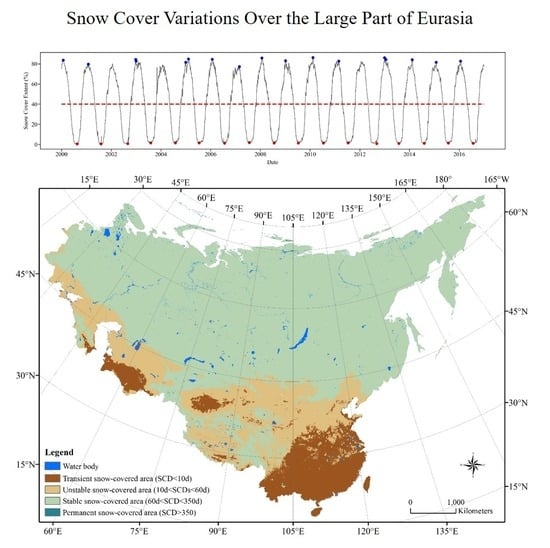Assessing Snow Phenology over the Large Part of Eurasia Using Satellite Observations from 2000 to 2016
Abstract
:1. Introduction
2. Data and Methods
2.1. Study Area
2.2. Data
2.2.1. Snow Cover Products from Satellite Remote Sensing
2.2.2. Data from Ground Observations
3. Methodology
3.1. Daily Cloud-Free Snow Cover Product
- (a)
- Daily synthesis of MOD10A1 and MYD10A1: Since the difference of imaging time between MOD10A1 and MYD10A1 is about 3 h and clouds will move during this period, the two products can be synthesized to remove cloud pixels. For two pixels at the same location on the same day, if one pixel represents cloud but the other one is snow or no snow, then we replaced the cloud pixel with snow or no snow. If two pixels are both recorded as cloud, then we kept the cloud pixel.
- (b)
- Adjacent day fusion: The snow cover will last several days on the ground. By comparing adjacent images, if a pixel is classified as “snow” or “no snow” on the previous day and next day, then the pixel of image on the current day can be classified as “snow” or “no snow”. If the classification of the previous and the next day of a pixel is inconsistent, that is, the previous day is classified as “snow”, and the next day is classified as “no snow”, or vice versa, then the image of the current day remains as cloud pixel.
- (c)
- Multiple snow products fusion: Using the above steps, a large portion of the cloud pixels are eliminated. Then the AMSR-E SWE and IMS products are used to eliminate the remaining cloud cover. For each day’s images, if a pixel in the AMSR-E SWE product shows SWE greater than 0, and IMS is snow, then the remaining cloud pixel is classified as snow; if SWE is greater than 0, but IMS is snow free, then the fusion product pixel is classified as snow free; if SWE is 0, then the cloud pixel is determined to be snow free.
- (d)
- Date gap filled: The correction method is similar as the AMSR-E correction, but is used to fill the date gap after AMSR-E data stopped on September 2, 2011. To ensure the daily snow product integrity, the data before the MOD10A1 data release was also filled in by IMS resampling data, supplemented by January 1, 2000 to February 23, 2000.
3.2. Validation
3.3. Snow-Covered Area Index (SCAI)
3.4. Snow Cover Parameters
3.5. Trend Analysis
4. Results
4.1. Snow Cover Product Validation
4.2. Spatiotemporal Dynamics of SCE
4.3. Temporal Dynamics of SCAI
4.4. SCDs Dynamics
4.5. Snow Phenology Dynamics
4.5.1. SOD
4.5.2. SED
4.5.3. SDDs
5. Discussion
5.1. Daily Cloud-Free Snow Cover Products
5.2. Cross-Validation of Snow Cover Phenomenon between Remote Sensing and Ground Observations
5.3. Heterogeneity Analysis
5.4. Comparisons with Previous Results
6. Conclusions
- (1)
- The snow cover accumulation begins in late September and reaches its maximum in early January, and the average maximum SCE reaches 79.8%. From the end of February, the snow cover begins to melt, and the ablation lasts until the end of May and reaches a minimum in early July. Although the snow cover in the Northern Hemisphere has decreased over the past 50 years [61,62], the results of this study indicate that SCE in the study area decreased only in June from 2000 to 2016; there is no obvious trend of daily SCE in the study area during the 17 years.
- (2)
- The stable snow cover areas, accounting for 78.8% of the study area, are mainly located north of latitude 45° N and the mountainous area of western China. The SCDs increase significantly in 6.4% and decrease significantly in 9.1% of the regions, respectively. The decreasing areas are mainly located in the Siberian Plateau, Mongolian Plateau and Tibetan Plateau, while the significant increase occurs mainly in the instantaneous snow cover areas of northeastern and southern China.
- (3)
- The variation in snow phenology is spatially heterogeneous. In the central Siberia, Pamir and Tibetan Plateau, the SOD tends to be delayed, the SED shows an advancing tendency, and the SDDs decrease from 2000 to 2016. While in the relatively low altitude plain areas, such as the West Siberian Plain and the Eastern European Plain region, the SOD tends to advance, the SED tends to be delayed, and the SDDs increase, but the increase is not significant.
Author Contributions
Funding
Acknowledgments
Conflicts of Interest
References
- Barnett, T.; Dümenil, L.; Schlese, U.; Roeckner, E. The effect of Eurasian snow cover on global climate. Science 1988, 239, 504–507. [Google Scholar] [CrossRef] [PubMed]
- Hansen, J.; Nazarenko, L. Soot climate forcing via snow and ice albedos. Proc. Natl. Acad. Sci. USA 2004, 101, 423–428. [Google Scholar] [CrossRef] [PubMed] [Green Version]
- Halder, S.; Dirmeyer, P.A. Relation of Eurasian snow cover and Indian summer monsoon rainfall: Importance of the delayed hydrological effect. J. Clim. 2017, 30, 1273–1289. [Google Scholar] [CrossRef]
- Chen, X.; Liang, S.; Cao, Y.; Wang, D. Observed contrast changes in snow cover phenology in northern middle and high latitudes from 2001–2014. Sci. Rep. 2015, 5, 1–9. [Google Scholar] [CrossRef] [Green Version]
- Trishchenko, A.P.; Wang, S. Variations of climate, surface energy budget, and minimum snow/ice extent over Canadian arctic landmass for 2000–2016. J. Clim. 2018, 31, 1155–1172. [Google Scholar] [CrossRef]
- Haynes, M.A.; Kung, K.-J.S.; Brandt, J.S.; Yongping, Y.; Waller, D.M. Accelerated climate change and its potential impact on Yak herding livelihoods in the eastern Tibetan plateau. Clim. Chang. 2014, 123, 147–160. [Google Scholar] [CrossRef]
- Cess, R.o.; Potter, G.; Zhang, M.H. Interpretation of snow-climate feedback as produced by 17 general circulation models. Science 1991, 253, 888–892. [Google Scholar] [CrossRef]
- Flanner, M.G.; Shell, K.M.; Barlage, M.; Perovich, D.K.; Tschudi, M.A. Radiative forcing and albedo feedback from the Northern Hemisphere cryosphere between 1979 and 2008. Nat. Geosci. 2011, 4, 151–155. [Google Scholar] [CrossRef]
- Thackeray, C.W.; Fletcher, C.G. Snow albedo feedback: Current knowledge, importance, outstanding issues and future directions. Prog. Phys. Geogr. 2016, 40, 392–408. [Google Scholar] [CrossRef]
- Parkinson, C.L. Earth’s cryosphere: Current state and recent changes. Annu. Rev. Environ. Resour. 2006, 31, 33–60. [Google Scholar] [CrossRef] [Green Version]
- Musselman, K.N.; Clark, M.P.; Liu, C.; Ikeda, K.; Rasmussen, R. Slower snowmelt in a warmer world. Nat. Clim. Chang. 2017, 7, 214–219. [Google Scholar] [CrossRef]
- Bulygina, O.; Razuvaev, V.; Korshunova, N. Changes in snow cover over Northern Eurasia in the last few decades. Environ. Res. Lett. 2009, 4, 045026. [Google Scholar] [CrossRef]
- Zhang, J.; Tian, W.; Chipperfield, M.P.; Xie, F.; Huang, J. Persistent shift of the Arctic polar vortex towards the Eurasian continent in recent decades. Nat. Clim. Chang. 2016, 6, 1094–1099. [Google Scholar] [CrossRef]
- Najafi, M.R.; Zwiers, F.W.; Gillett, N.P. Attribution of the spring snow cover extent decline in the Northern Hemisphere, Eurasia and North America to anthropogenic influence. Clim. Chang. 2016, 136, 571–586. [Google Scholar] [CrossRef] [Green Version]
- Cohen, J.; Furtado, J.C.; Jones, J.; Barlow, M.; Whittleston, D.; Entekhabi, D. Linking Siberian snow cover to precursors of stratospheric variability. J. Clim. 2014, 27, 5422–5432. [Google Scholar] [CrossRef]
- Mark, J.A.F.; Serreze, C. The Arctic on the fast track of change. Weather 2006, 61, 65–69. [Google Scholar]
- Intergovernmental Panel on Climate Change (IPCC); Working Group I Technical Support Unit. Climate Change 2013: The Physical Science Basis; Intergovernmental Panel on Climate Change: Geneva, Switzerland, 2013. [Google Scholar]
- Nolin, A.W. Recent advances in remote sensing of seasonal snow. J. Glaciol. 2010, 56, 1141–1150. [Google Scholar] [CrossRef] [Green Version]
- Choi, G.; Robinson, D.A.; Kang, S. Changing northern hemisphere snow seasons. J. Clim. 2010, 23, 5305–5310. [Google Scholar] [CrossRef]
- Cohen, J.; Screen, J.A.; Furtado, J.C.; Barlow, M.; Whittleston, D.; Coumou, D.; Francis, J.; Dethloff, K.; Entekhabi, D.; Overland, J.; et al. Recent Arctic amplification and extreme mid-latitude weather. Nat. Geosci. 2014, 7, 627. [Google Scholar] [CrossRef] [Green Version]
- Wang, Y.; Huang, X.; Liang, H.; Sun, Y.; Feng, Q.; Liang, T. Tracking snow variations in the Northern Hemisphere using multi-source remote sensing data (2000–2015). Remote Sens. 2018, 10, 136. [Google Scholar] [CrossRef] [Green Version]
- Brown, R.D.; Robinson, D.A. Northern Hemisphere spring snow cover variability and change over 1922–2010 including an assessment of uncertainty. Cryosphere 2011, 5, 219–229. [Google Scholar] [CrossRef] [Green Version]
- Mazari, N.; Ahmet, T.; Xie, H.; Sharif, H.; ElHassan, A.A. Assessment of ice mapping system and moderate resolution imaging spectroradiometer snow cover maps over Colorado Plateau. J. Appl. Remote Sens. 2013, 7, 073540. [Google Scholar] [CrossRef]
- Wulder, M.A.; Nelson, T.A.; Derksen, C.; Seemann, D. Snow cover variability across central Canada (1978–2002) derived from satellite passive microwave data. Clim. Chang. 2007, 82, 113–130. [Google Scholar] [CrossRef]
- Takala, M.; Luojus, K.; Pulliainen, J.; Derksen, C.; Lemmetyinen, J.; Karna, J.-P.; Koskinen, J.; Bojkov, B. Estimating northern hemisphere snow water equivalent for climate research through assimilation of space-borne radiometer data and ground-based measurements. Remote Sens. Environ. 2011, 115, 3517–3529. [Google Scholar] [CrossRef]
- Hall, D.K.; Foster, J.L.; Salomonson, V.V.; Klein, A.G.; Chien, J.Y.L. Development of a technique to assess snow-cover mapping errors from space. IEEE Trans. Geosci. Remote Sens. 2001, 39, 432–438. [Google Scholar] [CrossRef]
- Dye, D.G. Variability and trends in the annual snow-cover cycle in Northern Hemisphere land areas, 1972–2000. Hydrol. Process 2002, 16, 3065–3077. [Google Scholar] [CrossRef]
- Stocker, T.F.; Qin, D.; Plattner, G.K.; Tignor, M.M.B.; Allen, S.K.; Boschung, J.; Nauels, A.; Xia, Y.; Bex, V.; Midgley, P.M.; et al. Climate change 2013: The physical science basis. In Contribution of Working Group I to the Fifth Assessment Report of the Intergovernmental Panel on Climate Change; Cambridge University Press: Cambridge, UK, 2013. [Google Scholar]
- Rupp, D.E.; Mote, P.W.; Bindoff, N.L.; Scott, P.A.; Robinson, D.A. Detection and attribution of observed changes in Northern Hemisphere spring snow cover. J. Clim. 2013, 26, 6904–6914. [Google Scholar] [CrossRef]
- Brown, R.; Derksen, C.; Wang, L. A multi-data set analysis of variability and change in Arctic spring snow cover extent, 1967–2008. J. Geophys. Res. Atmos. 2010, 115, D16. [Google Scholar] [CrossRef]
- Hall, D.K.; Riggs, G.A.; Salomonson, V.V.; DiGirolamo, N.E.; Bayr, K.J. MODIS snow-cover products. Remote Sens. Environ. 2002, 83, 181–194. [Google Scholar] [CrossRef] [Green Version]
- Feng, Q.; Zhang, X.; Liang, T. Dynamic monitoring of snow cover based on MOD10A1 and AMSR-E in the north of Xinjiang Province, China. Acta Pratacult. Sin. 2009, 18, 125–133. [Google Scholar]
- Helfrich, S.R.; McNamara, D.; Ramsay, B.H.; Baldwin, T.; Kasheta, T. Enhancements to, and forthcoming developments in the Interactive Multisensor Snow and Ice Mapping System (IMS). Hydrol. Process 2007, 21, 1576–1586. [Google Scholar] [CrossRef]
- Liang, H.; Huang, X.; Sun, Y.; Wang, Y.; Liang, T. Fractional snow-cover mapping based on MODIS and UAV data over the Tibetan Plateau. Remote Sens. 2017, 9, 1332. [Google Scholar] [CrossRef] [Green Version]
- Liu, X.; Jin, X.; Ke, C. Accuracy evaluation of the IMS snow and ice products in stable snow covers regions in China. J. Glaciol. Geocryol. 2014, 36, 500–507. [Google Scholar]
- Huang, X.; Hao, X.; Wang, W.; Feng, Q.S.; Liang, T. Algorithms for cloud removal in MODIS daily snow products. J. Glaciol. Geocryol. 2012, 34, 1118–1126. [Google Scholar]
- Lee, Y.-K.; Kongoli, C.; Key, J. An in-depth evaluation of heritage algorithms for snow cover and snow depth using AMSR-E and AMSR2 measurements. J. Atmos. Ocean. Technol. 2015, 32, 2319–2336. [Google Scholar] [CrossRef]
- World Meteorological Organization (WMO). Guide to Meteorological Instruments and Methods of Observation, WMO-No. 8; Chairperson, Publications Board: Geneva, Switzerland, 1996. [Google Scholar]
- Yu, J.; Zhang, G.; Yao, T.; Xie, H.; Zhang, H.; Ke, C.; Yao, R. Developing Daily Cloud-Free Snow Composite Products From MODIS Terra-Aqua and IMS for the Tibetan Plateau. IEEE Trans. Geosci. Remote Sens. 2016, 54, 2171–2180. [Google Scholar] [CrossRef]
- Gao, Y.; Xie, H.; Lu, N.; Yao, T.; Liang, T. Toward advanced daily cloud-free snow cover and snow water equivalent products from Terra–Aqua MODIS and Aqua AMSR-E measurements. J. Hydrol. 2010, 385, 23–35. [Google Scholar] [CrossRef]
- Yang, J.; Jiang, L.; Ménard, C.B.; Luojus, K.; Lemmetyinen, J.; Pulliainen, J. Evaluation of snow products over the Tibetan Plateau. Hydrol. Process 2015, 29, 3247–3260. [Google Scholar] [CrossRef]
- Xianwei, W.; Xi, H. New methods for studying the spatiotemporal variation of snow cover based on combination products of MODIS Terra and Aqua. J. Hydrol. 2009, 371, 192–200. [Google Scholar]
- Stow, D.A.; Hope, A.; McGuire, D.; Verbyla, D.; Gamon, J.; Huemmrich, F.; Houston, S.; Racine, C.; Sturm, M.; Tape, K.; et al. Remote sensing of vegetation and land-cover change in Arctic Tundra Ecosystems. Remote Sens. Environ. 2004, 89, 281–308. [Google Scholar] [CrossRef] [Green Version]
- Zhang, T.J.; Zhong, X.Y. Classification and regionallization of the seasonal snow cover across the Eurasian Continent. J. Glaciol. Geocryol. 2014, 36, 481–490. [Google Scholar]
- Gafurov, A.; Bárdossy, A. Cloud removal methodology from MODIS snow cover product. Hydrol. Earth Syst. Sci. 2009, 13, 1361–1373. [Google Scholar] [CrossRef] [Green Version]
- Liang, T.G.; Huang, X.D.; Wu, C.X.; Liu, X.Y.; Li, W.L.; Guo, Z.G.; Ren, J.Z. An application of MODIS data to snow cover monitoring in a pastoral area: A case study in Northern Xinjiang, China. Remote Sens. Environ. 2008, 112, 1514–1526. [Google Scholar] [CrossRef]
- Hall, D.K.; Riggs, G.A.; Foster, J.L.; Kumar, S.V. Development and evaluation of a cloud-gap-filled MODIS daily snow-cover product. Remote Sens. Environ. 2010, 114, 496–503. [Google Scholar] [CrossRef] [Green Version]
- Huang, X.D.; Hao, X.H.; Wang, W.; Liang, T. A new MODIS daily cloud free snow cover mapping algorithm on the Tibetan Plateau. Sci. Cold Arid Reg. 2014, 6, 0116–0123. [Google Scholar]
- Parajka, J.; Pepe, M.; Rampini, A.; Rossi, S.; Blöschl, G. A regional snow-line method for estimating snow cover from MODIS during cloud cover. J. Hydrol. 2010, 381, 203–212. [Google Scholar] [CrossRef]
- Liang, T.; Zhang, X.; Xie, H.; Wu, C.; Feng, Q.; Huang, X.; Chen, Q.; Quangong, C. Toward improved daily snow cover mapping with advanced combination of MODIS and AMSR-E measurements. Remote Sens. Environ. 2008, 112, 3750–3761. [Google Scholar] [CrossRef]
- Hall, D.K.; Riggs, G.A. Accuracy assessment of the MODIS snow products. Hydrol. Process 2007, 21, 1534–1547. [Google Scholar] [CrossRef]
- Wang, W.; Huang, X.; Deng, J.; Xie, H.; Liang, T. Spatio-temporal change of snow cover and its response to climate over the Tibetan Plateau based on an improved daily cloud-free snow cover product. Remote Sens. 2015, 7, 169–194. [Google Scholar] [CrossRef]
- Huang, X.; Deng, J.; Ma, X.; Wang, Y.; Feng, Q.; Hao, X.; Liang, T. Spatiotemporal dynamics of snow cover based on multi-source remote sensing data in China. Cryosphere 2016, 10, 2453. [Google Scholar] [CrossRef] [Green Version]
- Zhang, Y.; Ma, N. Spatiotemporal variability of snow cover and snow water equivalent in the last three decades over Eurasia. J. Hydrol. 2018, 559, 238–251. [Google Scholar] [CrossRef]
- Rikiishi, K.; Nakasato, H. Height dependence of the tendency for reduction in seasonal snow cover in the Himalaya and the Tibetan Plateau region, 1966–2001. Ann. Glaciol. 2006, 43, 369–377. [Google Scholar] [CrossRef] [Green Version]
- Groisman, P.Y.; Knight, R.W.; Razuvaev, V.N.; Bulygina, O.N.; Karl, T.R. State of the ground: Climatology and changes during the past 69 years over northern Eurasia for a rarely used measure of snow cover and frozen land. J. Clim. 2006, 19, 4933–4955. [Google Scholar] [CrossRef]
- Qin, D.H.; Liu, S.Y.; Li, P.J. Snow cover distribution, variability, and response to climate change in western China. J. Clim. 2006, 19, 1820–1833. [Google Scholar]
- Ye, H.; Ellison, M. Changes in transitional snowfall season length in northern Eurasia. Geophys. Res. Lett. 2003, 30, 1252. [Google Scholar] [CrossRef]
- Zhou, H.; Aizen, E.; Aizen, V. Seasonal snow cover regime and historical change in Central Asia from 1986 to 2008. Glob. Planet. Change 2017, 148, 192–216. [Google Scholar] [CrossRef] [Green Version]
- Huang, X.; Deng, J.; Wang, W.; Feng, Q.; Liang, T. Impact of climate and elevation on snow cover using integrated remote sensing snow products in Tibetan Plateau. Remote Sens. Environ. 2017, 190, 274–288. [Google Scholar] [CrossRef]
- Notarnicola, C. Hotspots of snow cover changes in global mountain regions over 2000–2018. Remote Sens. Environ. 2020, 243, 111781. [Google Scholar] [CrossRef]
- Wang, X.; Wu, C.; Wang, H.; Gonsamo, A.; Liu, Z. No evidence of widespread decline of snow cover on the Tibetan Plateau over 2000–2015. Sci. Rep. 2017, 7, 1–10. [Google Scholar] [CrossRef]
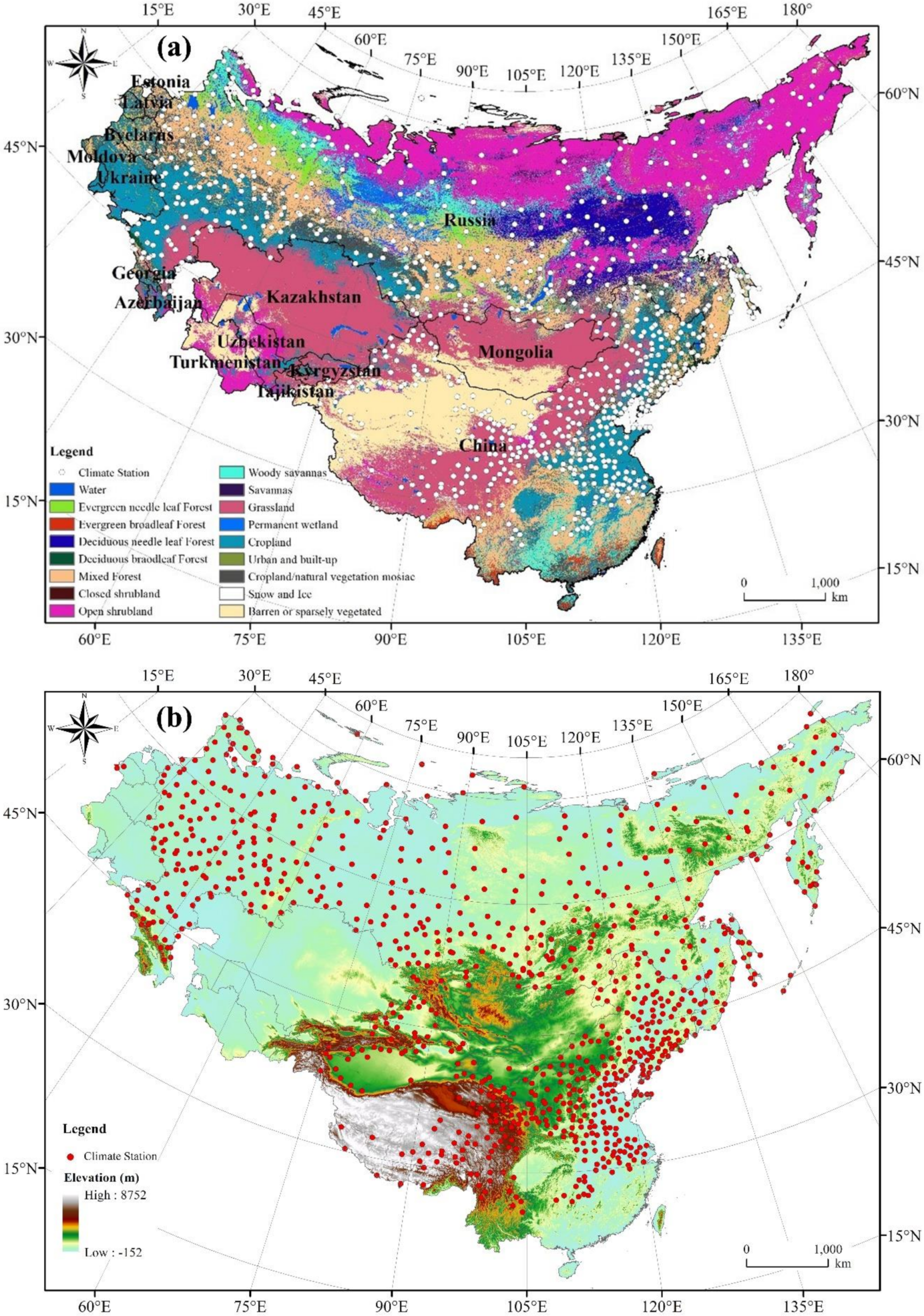
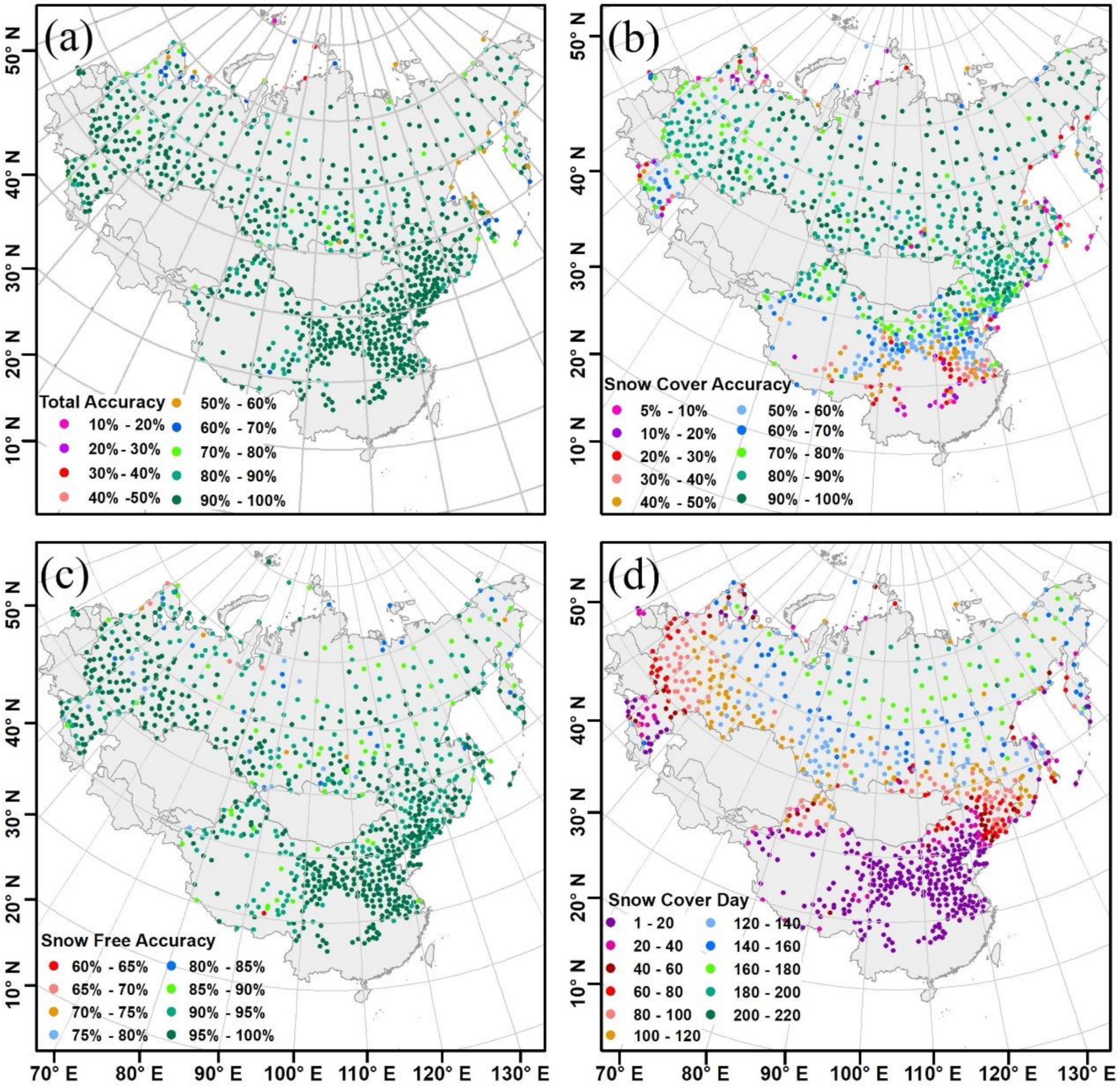
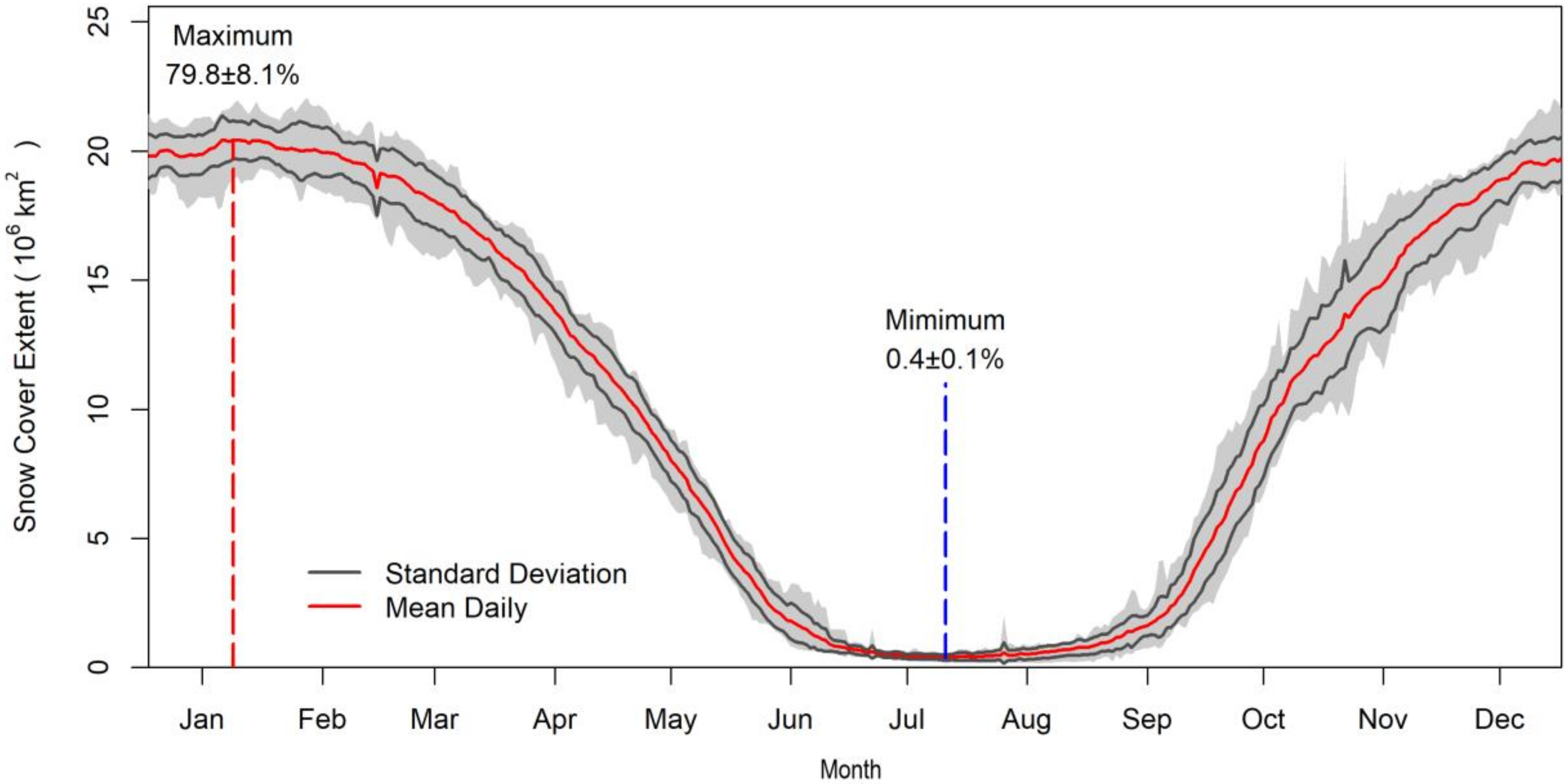
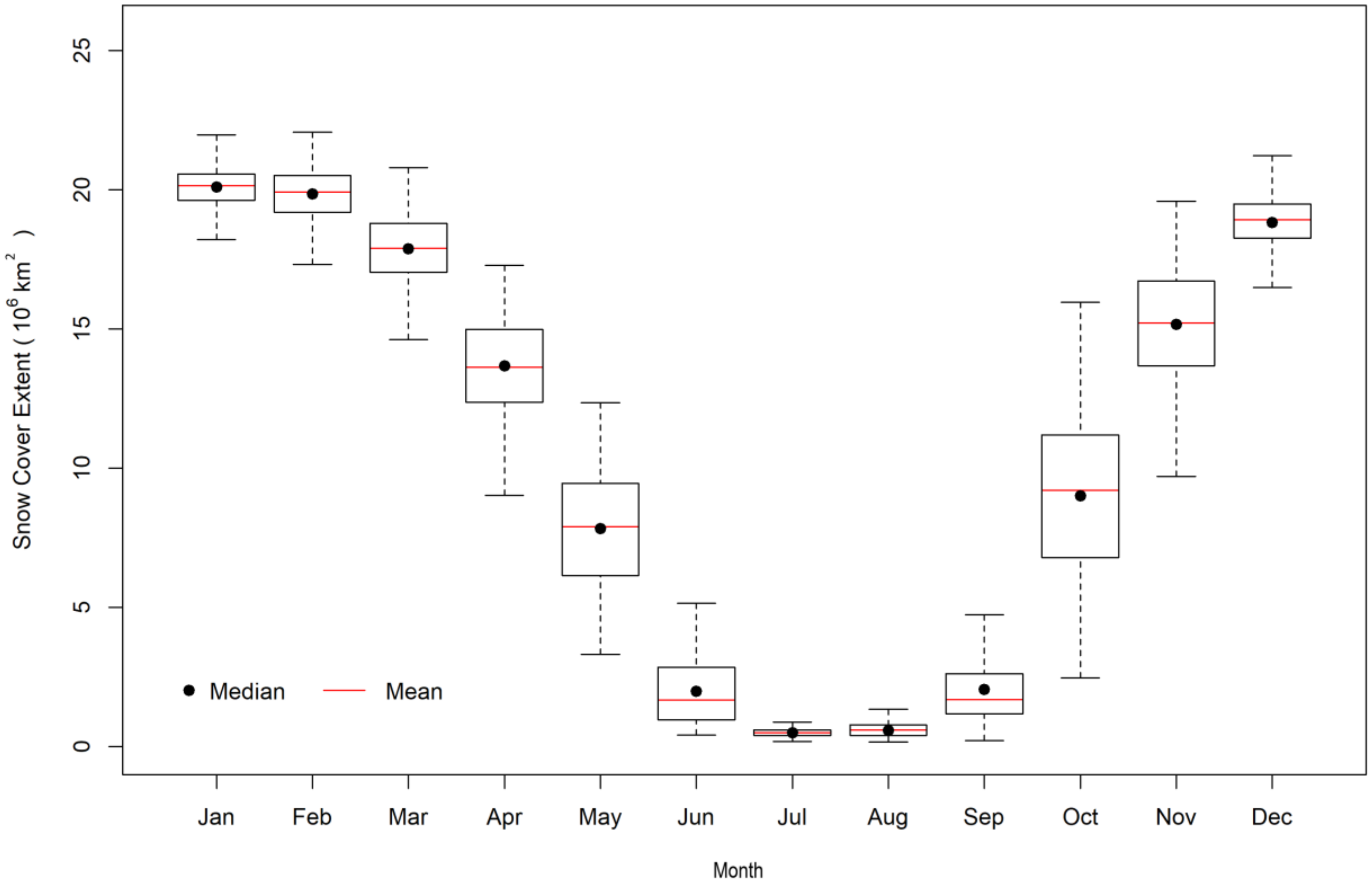
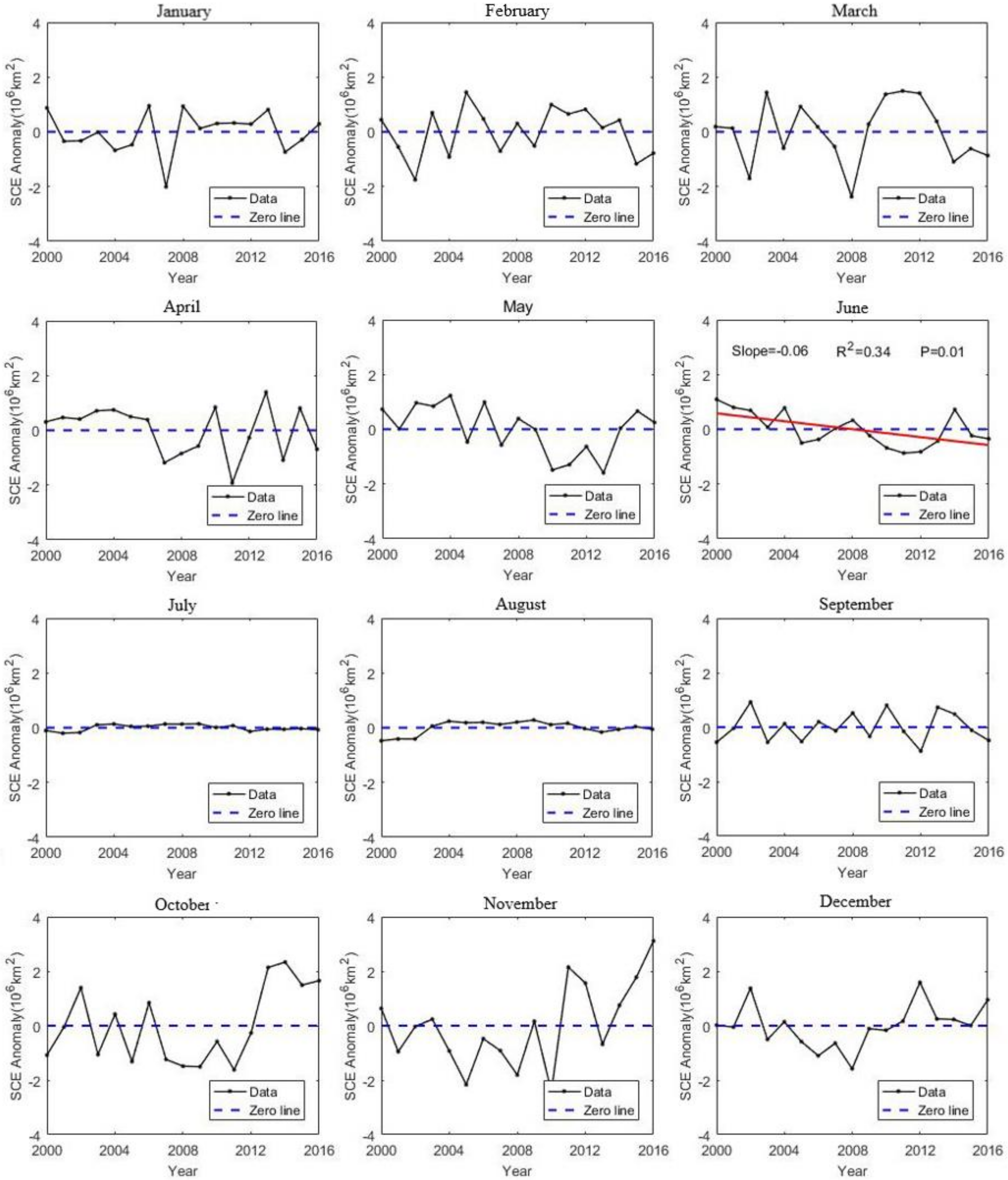

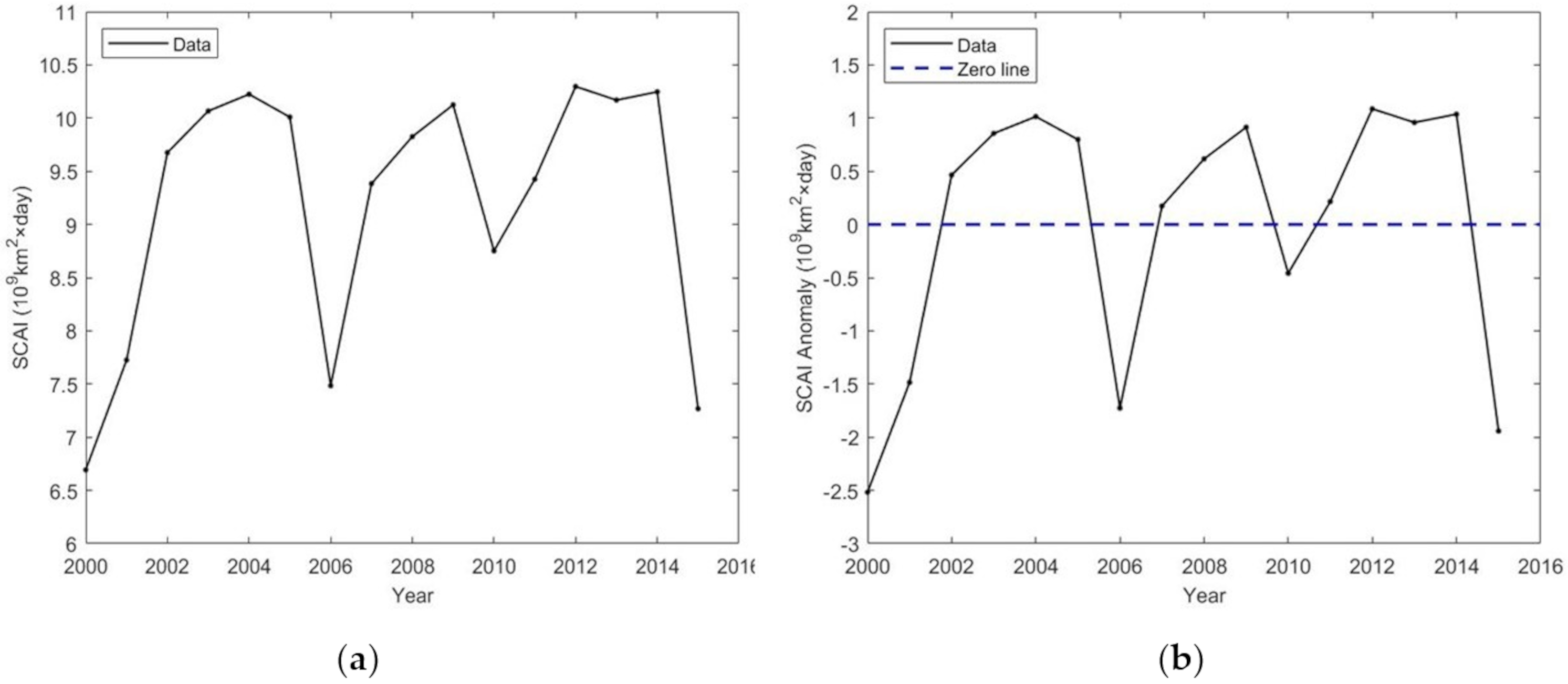

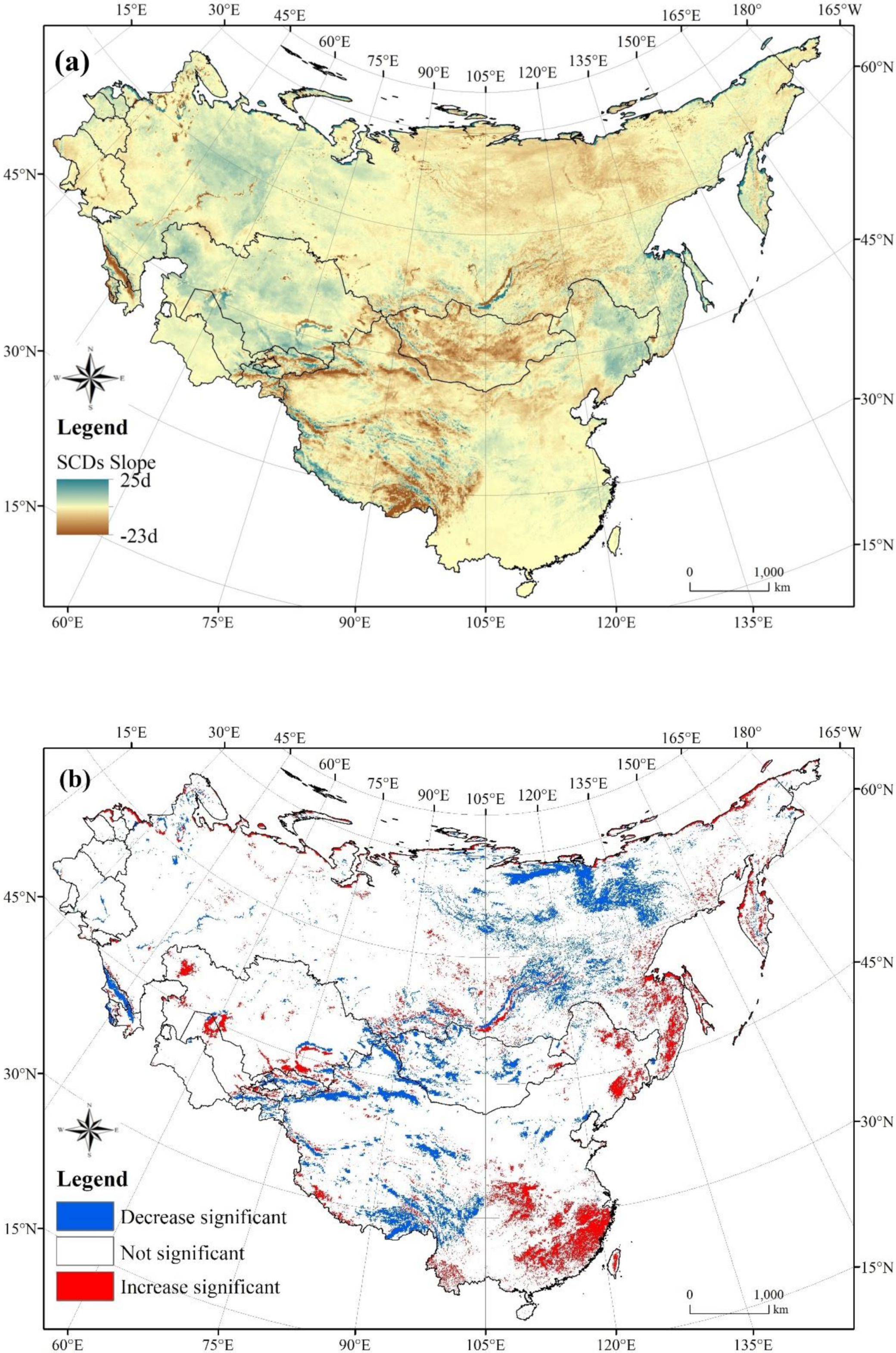
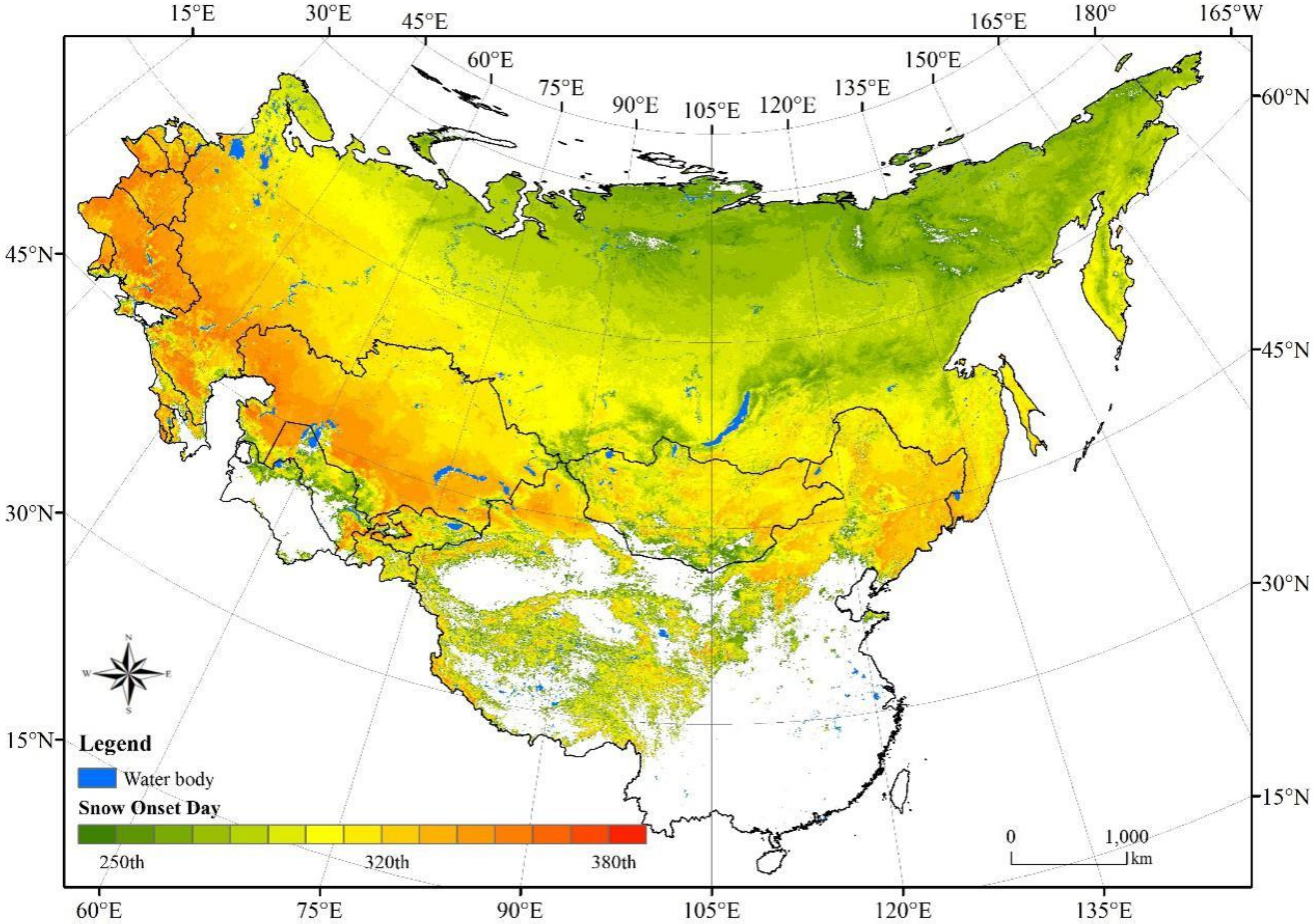
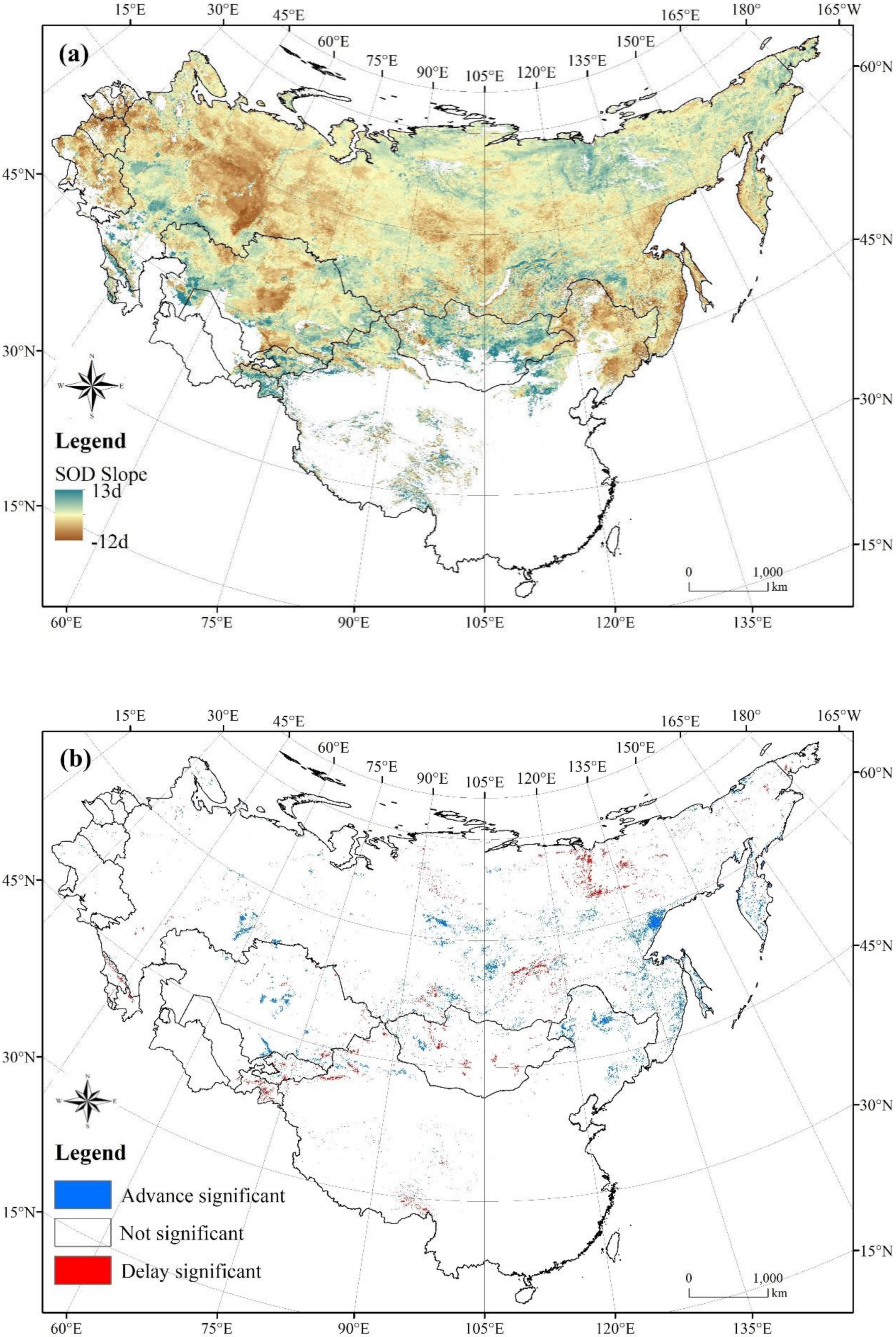



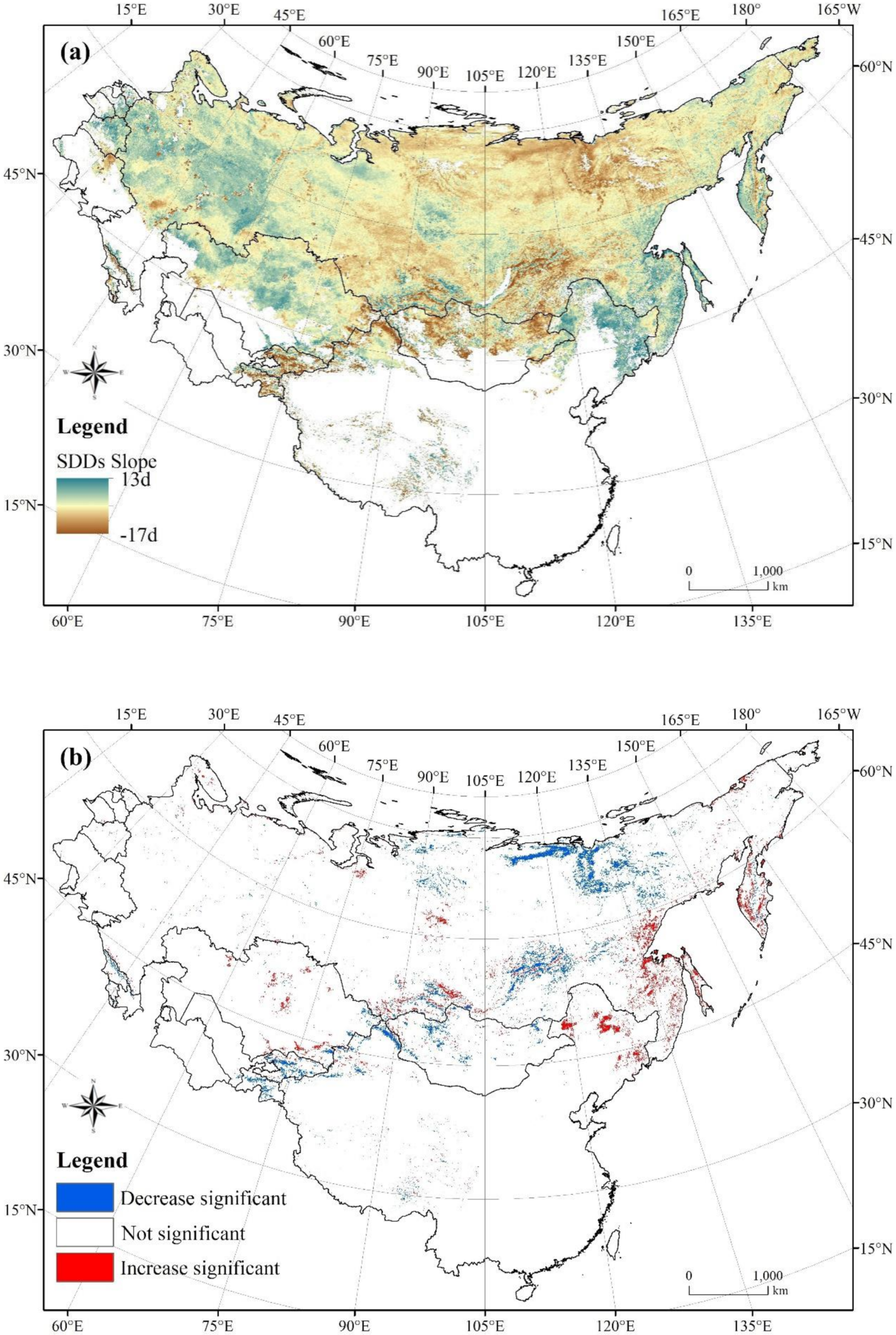


| Dataset | Resolution (km) | Period |
|---|---|---|
| MOD10A1 | 0.5 | February 24, 2000–December 31, 2016 |
| MYD10A1 | 0.5 | September 4, 2002–December 31, 2016 |
| AMSR-E | 25 | September 4, 2002–September 2, 2011 |
| IMS | 24 | January 1, 2000–September 4, 2002 |
| 4 | September 4, 2011–December 1, 2014 | |
| 1 | December 2, 2014–December 31, 2016 |
© 2020 by the authors. Licensee MDPI, Basel, Switzerland. This article is an open access article distributed under the terms and conditions of the Creative Commons Attribution (CC BY) license (http://creativecommons.org/licenses/by/4.0/).
Share and Cite
Sun, Y.; Zhang, T.; Liu, Y.; Zhao, W.; Huang, X. Assessing Snow Phenology over the Large Part of Eurasia Using Satellite Observations from 2000 to 2016. Remote Sens. 2020, 12, 2060. https://doi.org/10.3390/rs12122060
Sun Y, Zhang T, Liu Y, Zhao W, Huang X. Assessing Snow Phenology over the Large Part of Eurasia Using Satellite Observations from 2000 to 2016. Remote Sensing. 2020; 12(12):2060. https://doi.org/10.3390/rs12122060
Chicago/Turabian StyleSun, Yanhua, Tingjun Zhang, Yijing Liu, Wenyu Zhao, and Xiaodong Huang. 2020. "Assessing Snow Phenology over the Large Part of Eurasia Using Satellite Observations from 2000 to 2016" Remote Sensing 12, no. 12: 2060. https://doi.org/10.3390/rs12122060
APA StyleSun, Y., Zhang, T., Liu, Y., Zhao, W., & Huang, X. (2020). Assessing Snow Phenology over the Large Part of Eurasia Using Satellite Observations from 2000 to 2016. Remote Sensing, 12(12), 2060. https://doi.org/10.3390/rs12122060





